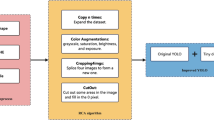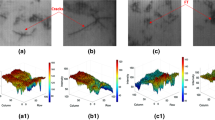Abstract
Tablet crack detection is an important part to ensure drug quality in the process of drug production. In view of the problems of target detection algorithm in the actual tablet crack detection, such as few training samples and the embedded device based on ARM architecture is difficult to accommodate the algorithm when the system is implemented, this paper proposes a tablet crack detection algorithm based on improved YOLOv5. The collected data set is processed by data enhancement, and YOLOv5 algorithm is improved by using fusion involution and varifocal loss to detect tablet cracks. The improved tablet crack detection algorithm improves the accuracy and speed of model detection. In the detection system designed with Raspberry Pi as the core, the crack detection mAP50 is 99.5%, and the reasoning speed is reduced from 797 ms to 299 ms. After the model is converted and simplified, the reasoning speed is reduced to 86 ms, which meets the design requirements of the crack detection system based on ARM architecture.
Access this chapter
Tax calculation will be finalised at checkout
Purchases are for personal use only
Similar content being viewed by others
References
Cui, Y., Liu, Z., Lian, S.: A survey on unsupervised industrial anomaly detection algorithms (2022). arXiv preprint arXiv:2204.11161
Wang, H., Liu, X., Chen, Y.: Detection of capsule foreign matter defect based on BP neural network. In: 2014 IEEE International Conference on Granular Computing (GrC), pp. 325–328. IEEE (2014)
Yueqiu, J., Shuang, M., Hongwei, G., Fei, X.: Research on defect detection technology of tablets in aluminum plastic package. Open Autom. Control Syst. J. 6(1), 940–951 (2014)
Puneeth, K.S., Sahay, A., Shreya, G.H., et al.: Designing an affordable system for early defect detection using image processing. Adv. Transdisciplinary Eng. 9, 121–128 (2019)
Ma, X., et al.: Deep learning convolutional neural networks for pharmaceutical tablet defect detection. Microscopy and Microanalysis, 26(S2) (2020)
Yang, J., Wang, Y., Wang, Z., et al.: Using stochastic gradient descent and deep learning to defect detection for medicinal hollow capsule. In: 2021 China Automation Congress (CAC), pp. 4926–4933. IEEE (2021)
Redmon, J.,Divvala, S., Girshick, R., et al.: You only look once: unified, real-time object detection. In: IEEE Conference on Computer Vision and Pattern Recognition, pp. 1–10. Las Vegas (2016)
Redmon, J.,Farhadi, A.: YOLO9000: better, faster, stronger. IEEE Conference on Computer Vision and Pattern Recognition, 1–9 (2017)
Redmon, J., Farhadi, A.: YOLOv3: anincremental improvement (2018). arXiv:1804.02767
Bochkovskiy, A.,Wang, C.Y., Liao, H.Y.M.: YOLOv4: optimal speed and accuracy of object detection. In: IEEE Conference on Computer Vision and Pattern Recognition (CVPR) (2020)
Zhang, R.: Making convolutional networks shiftinvariant again. In: ICML (2019)
Simonyan, K., Zisserman, A.: Very deep convolutional networks for large-scale image recognition. In: ICLR (2015)
Li, D.,et al.: Involution: inverting the inherence of convolution for visual recognition. In: Proceedings of the IEEE/CVF Conference on Computer Vision and Pattern Recognition (CVPR), pp. 12321–12330 (2021)
Lin, T.-Y., Goyal, P., Girshick, R., He, K., Dollár, P.: Focal loss for dense object detection. In: ICCV (2017)
Zhang, H., Wang, Y., Dayoub, F., Sunderhauf, N.:.VarifocalNet: an IoU-aware dense object detector. In: Proceedings of the IEEE/CVF Conference on Computer Vision and Pattern Recognition (CVPR), pp. 8514–8523 (2021)
Acknowledgment
The special fund for innovation and Entrepreneurship of Postgraduates of Inner Mongolia University (11200–121024).
Author information
Authors and Affiliations
Corresponding author
Editor information
Editors and Affiliations
Rights and permissions
Copyright information
© 2023 The Author(s), under exclusive license to Springer Nature Singapore Pte Ltd.
About this paper
Cite this paper
Zhu, H., Zhang, X., Li, X., Shi, Q., Wang, S. (2023). Research on Tablet Crack Detection Algorithm Based on Improved YOLOv5. In: Liang, Q., Wang, W., Liu, X., Na, Z., Zhang, B. (eds) Communications, Signal Processing, and Systems. CSPS 2022. Lecture Notes in Electrical Engineering, vol 873. Springer, Singapore. https://doi.org/10.1007/978-981-99-1260-5_9
Download citation
DOI: https://doi.org/10.1007/978-981-99-1260-5_9
Published:
Publisher Name: Springer, Singapore
Print ISBN: 978-981-99-1259-9
Online ISBN: 978-981-99-1260-5
eBook Packages: EngineeringEngineering (R0)




